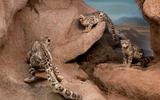
Snow leopard
Panthera uncia
Habitat
Mountain ranges of Central Asia and the Himalayas, at elevations of around 2,700–5,500 m above sea level
Conservation status
Vulnerable. Threats include the decline of wild prey species (due to hunting) and conflicts with farmers, as the snow leopard also preys on livestock such as sheep and dogs. The species is also at risk from climate change since large areas of its barren habitat are likely to become forested. In addition, the snow leopard is a target for poachers: its skin is highly prized and its bones — like those of the tiger — are believed to have medicinal powers. But the elusive big cat is more than just an animal to be hunted or a threat to livestock: traditionally, it has been venerated by indigenous peoples as the protector of the mountains and a source of spiritual power.
Biology
This perfectly camouflaged ambush predator can kill prey three times its own weight. That includes, for example, the bharal (blue sheep) and Siberian ibex, but also livestock. This leads to conflicts — as is the case whenever habitats are shared by predators and humans.

Diorama
1978
Adult snow leopards are solitary, only coming together to mate. A group of three snow leopards — shown in the diorama — will rarely be observed in the wild.
Provenance
1976, Männchen, Zoo Basel; 1968, 2 Felle, Herkunft Mongolei, Donation ans Museum, Stiftung Alpine Forschung